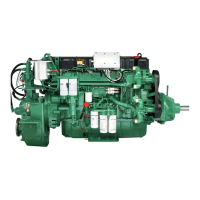D
Group 20
High Fuel Consumption, Fault Tracing
Symptom fault tracing
Depending on the vehicle configuration, conditions related
to high fuel consumption may be caused or influenced
by specific faults or malfunctions in other vehicle
components. These include components such as tires,
axles, the trailer, bodybuilder adaptations, etc. In such
cases refer to the Service Information to that component.
Note: You must read and understand the precautions
and guidelines in Service Information, group 20,
"General Safety Practices, Engine" before performing any
suggested procedures. If you are not properly trained and
certified in a procedure, ask your supervisor for training
before you perform it.
“General Information” page 36
For specific symptoms, see:
•
“Abnormally High Fuel Consumption” page 37
“Symptom, Fault Tracing” page 3
General Information
C2002642
Note: During fault-tracing, the engine should be run at
the operating temperature as well as at the temperature
where the symptom occurs.
It is often difficult to determine the causes of high fuel
consumption. This fault tracing information focuses on
engine-related faults which have a direct affect on fuel
consumption. If the fault tracing procedure does not
identify any faults, interview the driver fully and carry
out an evaluation of the vehicle usage and operating
conditions.
Note that the engine consumes the amount of fuel
required to carry out a particular workload. If the workload
increases, the fuel consumption will also increase.
The cause of abnormally high fuel consumption may not
necessarily be attributed to an engine related fault. The
most probable cause is that the workload has increased
for some reason. It is therefore important that the whole
vehicle is checked for factors which could affect the fuel
consumption.
•
The fuel consumption is most affected by the vehicle
operating conditions, including driver habits. The driver
is the most important factor in achieving good fuel
economy. Uneven driving, with frequent acceleration
and braking, or driving at high speeds, will increase
fuel consumption. Proper driving techniques will save
fuel and reduce vehicle wear. Carefully evaluate
trip data stored in the engine control unit before
starting fault tracing.
•
When there is high fuel consumption combined with
low power output, it is important to first fault-trace the
causes of low power output. Correcting a low power
condition will often remedy a problem with high fuel
consumption
•
Check whether there are Service Bulletins or other
information (i.e. campaigns) that affect the truck. If
36

